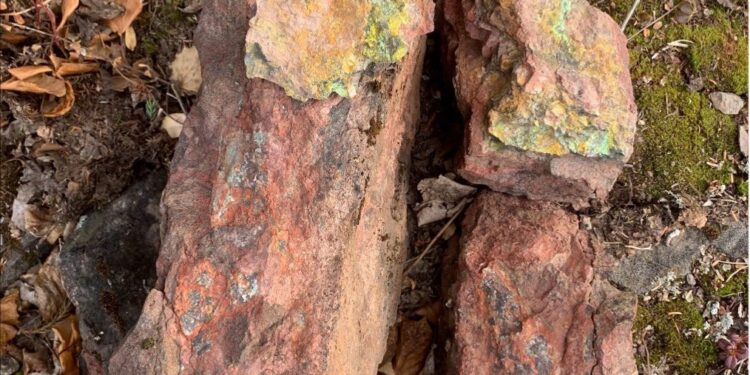Valor Resources Limited (ASX: VAL) has further enhanced the potential of its 100%-owned Surprise Creek Uranium Project, located near the Beaverlodge Uranium District in northern Saskatchewan, Canada, with follow-up field work.
The field programme mainly comprised geological mapping and geochemical sampling in the Surprise Creek Fault area and was designed to follow-up reconnaissance work undertaken in July which returned several rock chip assay results of >1% U3O8 and up to 6.13% U3O8 and 1.03% Cu.
The latest results have successfully extended the area of surface uranium mineralisation at Surprise Creek Fault to nearly 400m strike length, uncovering five showings with maximum scintillometer readings of 65,535 cps and several more with over 10,000 cps.
Final assay results for the latest round of sampling are expected within four to six weeks.
A total of 50 rock chip samples were collected in the programme, of which 31 samples were collected from the Surprise Creek Fault prospect.
Detailed geological mapping was also undertaken over the area around the Surprise Creek Fault, with results highlighting compelling geological similarities to some of the more significant uranium deposits within the Beaverlodge district such as Fay-Ace and Gunnar.
“The follow-up programme targeting the Surprise Creek Fault prospect has successfully extended the area of uranium mineralisation and given us strong impetus to drill test this target in 2023,” Executive Chairman George Bauk said.
“The known deposits in this part of the Beaverlodge district produced about 57 million pounds of uranium historically, highlighting the potential of this area to yield very significant uranium deposits.
“Prior to drilling, we plan to complete detailed airborne radiometrics and magnetics across the entire Surprise Creek project area to identify other potential uranium targets as well as enhance our structural understanding to assist with drill planning.
“We also plan to follow-up known copper occurrences in the southern and western portions of the Project, which appear to represent widespread mineralisation in an area where we have very limited geological data.”
Surprise Creek Fault Target
Historical drilling at the Surprise Creek Fault prospect from 1968 returned significant intercepts including 2.1m @ 4.37% U3O8 from 57m (VT20) including 0.9m at 7.5% U3O8.
First-pass on-ground reconnaissance of this area was completed by Valor in July this year, with assay results reported in October 2022. Of the 11 rock chip samples taken at Surprise Creek Fault, six returned assays of >1% U3O8, with a peak assay of 6.13% U3O8.
All the >1% U3O8 samples returned anomalous copper results, with a highest assay of 2.57% Cu.
During the most recent field programme, a hand-held RS-125 scintillometer was used to identify uranium mineralisation with five sample locations recording maximum readings (>65,535cps) and another ten sample locations recording >5,000cps, with multiple other occurrences of anomalous scintillometer readings present in the area.
The scintillometer reading locations are selective in nature and therefore have a high potential for bias and should not be considered as being representative of the overall mineralised structure or zone. A total of 31 samples were collected from the prospect area which have been submitted for assay.
The Surprise Creek Fault is a north-northwest trending fault zone within orthogneisses and mylonite with widespread interpreted albitisation.
Uranium mineralisation was predominantly found within northeast-southwest and east-west trending carbonate-hematite veins and hematitic breccias, with chlorite alteration and is variably associated with copper (visible malachite) +/- lead mineralisation.
The higher-grade uranium mineralisation occurs around the intersection of the Surprise Creek Fault and a north-northeast trending mylonitic zone.
The geological mapping has identified outcropping younger Martin Group red beds (sandstones) which occur unconformably and/or in faulted contact with the older basement orthogneisses.
The geological setting of the Surprise Creek Fault prospect shares many similarities with the geology of two of the most significant Beaverlodge Uranium District deposits, Fay-Ace and Gunnar, which are located around 25km south-east and 30km south of Surprise Creek respectively.
Copper Targets
Follow-up of the copper occurrences identified in the July field program was also carried out as part of the October field programme. A further 17 samples were collected in this area targeting the copper occurrences.
Figure 5 below shows where copper occurrences have been confirmed in the field along with the high-grade samples from the July field program. The host rocks for most of these copper occurrences are mylonitic granitic rocks and/or metasediments with disseminated sulphides and copper oxides.
Further copper occurrences have been located close to the unconformity between the Thluico Lake Group sediments and the older Tazin Group mylonites suggesting a possible genetic link
For further information please visit: https://www.valorresources.com.au/










